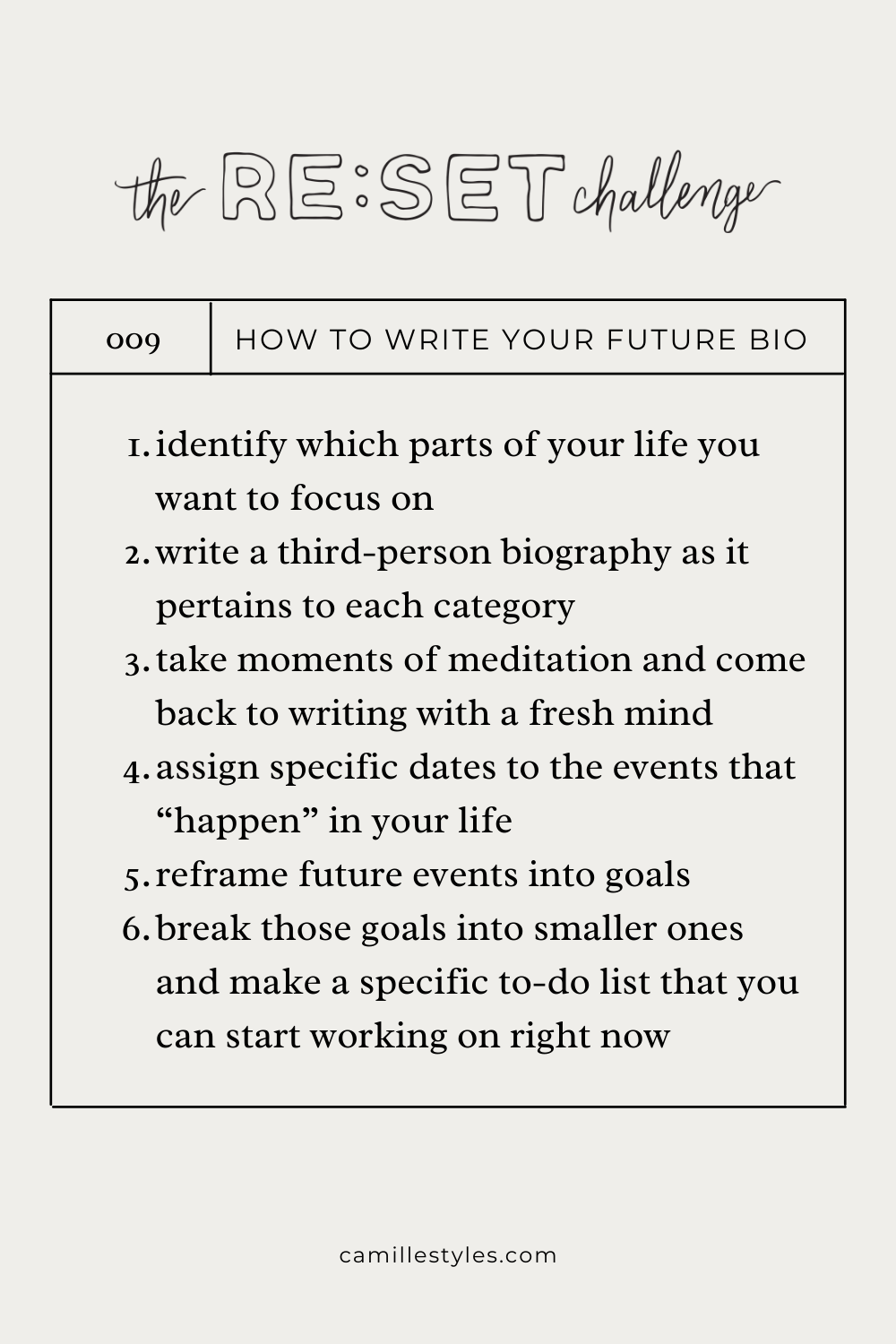There’s way more to wellness than just eating clean, so we’re taking a holistic approach to restoring our spaces, minds, bodies, and hearts in small but powerful ways. Introducing The RE:SET Challenge—a 21-day plan to a healthier and happier you. Click here for the full list. Next up, how to write your “future bio” with this goal-setting technique.
Today I’m excited to share a small but mighty goal-setting technique that’s been key in helping me prioritize what I spend my time on and ultimately, reach my most important goals. It’s called a “future bio,” and in a nutshell, it’s writing down a third-person account of what I want my biography to say five years from now. I’ll be honest that doing this exercise requires some time and personal reflection, but I promise that the extra effort it takes to sit down and do it is so worth it to ensure that we’re not wasting time on things that don’t really matter to us.
For me, the biggest benefit of a future bio is that it helps me step outside the day-to-day grind and take a big picture view of the overall narrative of my own life.
I personally find this really challenging—as someone who loves a to-do list and tends to be a creature of habit, taking time out to look at life more holistically takes real effort. But I’ve learned that it’s absolutely crucial in order to keep growing in my career, relationships, health, and happiness.

Here’s how a future bio works:
1. Identify which parts of your life you want to focus on. I personally don’t have the patience to cover every single sphere of life in one sitting, so I start by choosing one or two categories that are most important to me: career, relationships, health, philanthropy, creativity, etc.
2. Next, write a third-person biography as it pertains to each category… as you would like it to read five years from now. This is the life that you dream about, the life that you’re about to make a reality by aligning your priorities to make sure you’re headed in the direction of this dream. You might do this in an hour one Saturday morning, or it might be something that you spend a few minutes working on every evening for a week. And it doesn’t have to be a novella; more important than length is to allow yourself the time and headspace to actually think. Fight the reflex to go with the first thing that pops into your head because that can be a recipe for complacency. Think outside-the-box and don’t be afraid to dream even bigger. Why five years? It’s somewhat arbitrary, but for me, five years is enough time to give a bigger perspective on where my life is headed, but not so far in the future I have no idea what my life might look like.
3. If you feel stuck, this can be a great time to take a moment for prayer, meditation, or a walk. Let your mind drift a bit and then come back to your bio with a fresh perspective. One of the most valuable parts of this exercise is that it allows some of those hopes and dreams that may have been floating around in your subconscious to come to the surface and be manifested on paper.
4. Assign specific dates to the events that “happen” in your life. For example, “In September of 2020, Camille’s Tastemakers series got picked up as a food and travel-focused show on Netflix.” Or “The summer or 2019 saw Camille taking a month off work to rent a house at the beach and spend uninterrupted time with her husband and kids.”
5. Once your bio is written, create new pages where each future event is reframed as a goal. Now it’s time to strategize and take action on those items that you want to achieve. I like the SMART goals system that says goals should be Specific, Measureable, Attainable, Relevant, and Time-bound. Setting goals with these qualities allow me to create the tangible steps I’ll need to take in order to achieve them. Using my Netflix show dream as an example, I might say “My goal is to have a food and travel television show with major distribution in the next 2 years.
6. Next, break those goals into smaller bite-sized goals (ie. launch season 2 of Tastemakers on CamilleStyles.com in early 2019 with a digital partner who can help grow the audience), and write a specific to-do list of tasks I can start working on right now to work towards those smaller goals (ie. start reaching out to my top-choice cookbook authors as interview subjects on season 2 to book shoot dates in Austin.)
And just like that, those fuzzy, abstract “dreams” become real, actionable goals that you’re empowered to work towards starting TODAY.

image by Sara Tramp for Emily Henderson
Writing your future bio can help identify the gaps in where you’re spending your time and what you may not be prioritizing. What are the areas that you say are important to you, but that you’re not actively working towards? Are there parts of your future bio that scare you? Pay attention to those feelings as they come up, and allow them to speak to you about where you might need to make a shift.
The whole point of this exercise is that you have the power to change the narrative of your own life, and mapping it out for the future equips you with the right goals so you can feel empowered and strong since you know exactly where you want to be headed.
The key isn’t necessarily that events play out exactly the way we write them down; after all, unexpected things in life happen every day, and it’s important to stay open and nimble to the doors that open to us. In fact, they might even prove better than what we’ve dreamed for ourselves! The goal is to hone our priorities and makes us consider whether the way we’re spending our hours, days, and months adds up to the life that we actually want to be living.






